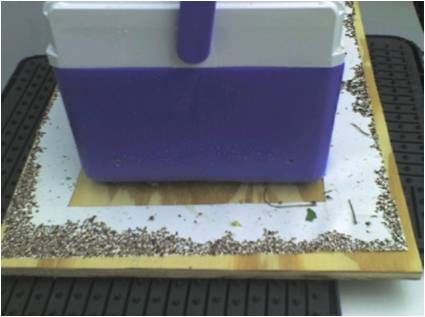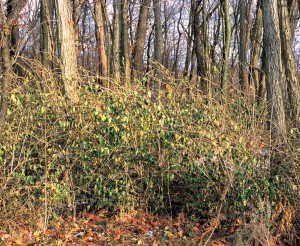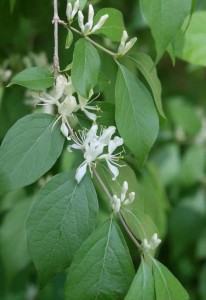Ticks, honeysuckle & deer ~~ another reason to remove invasive bush honeysuckle!
May is beautiful, bountiful, busy, AND is Illinois Invasive Species Awareness Month. Just in time to celebrate growing awareness of the problems invasive species create, we have an all new reason to get rid of bush honeysuckle, the single greatest threat to our bluff land’s natural biodiversity and the worst of the worst of invasive plant species in our area. Dr. Mike Kirk, Progressive Family Care, Waterloo, and Dr. Brian Allan, Department of Entomology, University of Illinois-Urbana, tied together the nature of the threats to human health found in the relationships between bush honeysuckle, white-tailed deer, and ticks during a recent Clifftop seminar on tick-borne disease.

Want to know just how many ticks live near you? Brian Allan gave a recipe for a “tick trap” during our recent seminar. The trap is based on the simple fact that ticks sense carbon dioxide to detect and find host animals. The dry ice in Brian’s trap gives off carbon dioxide as it melts and the ticks get stuck on the double-sided tape as they rush towards the “scent” of a hoped-for next meal. His highest trap-rate capture was approximately 5,000 ticks in a 24-hour period. How to construct and use a CO2 trap for collecting ticks: Equipment needed to construct and use a CO2 trap: 1) lunch-size cooler 2) plywood board cut to the same dimensions of the footprint of the cooler, plus an additional 2.5” on each side 3) two screws and bolts to attach cooler to the board 4) drill 5) deck sealant & brush 6) double-sided carpet tape (I recommend 3M 345PQ Scotch brand carpet tape in 2” x 36 yard rolls) 7) dry ice & food scale. Instructions to construct a CO2 trap: 1) Cut the board to the appropriate size. Apply a coat of deck sealant to all sides of the board (especially the edges) to protect from the elements. 2) Drill holes through the vertical walls of the cooler (near the bottom) to allow CO2 gas to escape. 3) Drill two holes in the bottom of the cooler and through the board. 4) Attach the board to the bottom of the cooler using two screws with bolts (just one screw will loosen and the cooler will spin on the board getting stuck in the carpet tape). Instructions to use a CO2 trap: 1) Apply double-sided carpet tape to the board around the outside of the cooler using the 2.5” of board protruding on each side. Use fresh carpet tape for each trapping event. 2) Measure out an appropriate quantity of dry ice (I like to use 1 kilogram of dry ice for a 24 hour period of trap deployment) and place inside the cooler. 3) Place the trap in the desired location for the desired period of time. Try to place the trap on level ground, and make sure that no vegetation allows ticks access to the trap while bypassing the carpet tape.
Bush honeysuckle thickets are favorite hiding and cover areas for white-tailed deer. While deer don’t eat much honeysuckle, they do spend a lot of time resting in the thickets where they are quite safe and protected even during hunting season, for even the most skillful of our hunters can’t make a stealthy approach into the area and can’t see to make a clean shot from outside the tangles. The regular congregations of deer in honeysuckle areas results in a secondary infestation within the masses of plants: enormous populations of ticks that are very likely to transmit infectious bacteria.
Bush honeysuckle, white-tailed deer, and ticks are combining to cause new dangers to human health. This cycle of infectious disease risk is rooted in the self-perpetuating monoculture that bush honeysuckle shrubs create, their expansion through the range of the lone star tick (Amblyomma americanum), and the population explosion of white-tailed deer, which serve as both the reservoir host of new infectious disease-causing bacteria and as the primary host to ticks taking blood meals.
Blood is a tick’s only food source and at each life stage – larva, nymph, and adult – a tick searches for, attaches to and draws sustenance from available hosts: birds, reptiles, or mammals. In a diverse community of wildlife, a tick is as likely to take a blood meal from a turtle or a turkey as it is from a deer.
In a honeysuckle monoculture a tick is most likely to find its food – and some bacteria floating in the blood — by attaching to a white-tailed deer, the primary wildlife host for pathogens that cause Ehrlichioisis and Southern Tick-Associated Rash Illness (STARI). Lone star ticks, the most common tick species in our area, can transmit these bacteria to and from deer and to us.
Ehrlichiosis most often results in flu-like symptoms but can be a severe and, rarely, a life-threatening illness; STARI causes a large bull-eye’s shaped rash at the site of a tick bite and also can result in flu-like illness. While the rash of STARI also is a symptom associated with Lyme disease, the illnesses are different. Lone star ticks do not carry the bacteria that cause Lyme disease; the salvia of this species of tick contains an enzyme that kills the bacteria causing Lyme disease.
The sheer numbers of the deer – especially when they live out their lives in a wildlife monoculture largely composed of their own species – increase the probabilities that they will serve as reservoirs, or carriers, of illness. As they take their meals, ticks then transmit disease from animal to animal, increasing the overall numbers of deer that carry bacteria and, in turn, pass forward bacteria to new generations of ticks. The presence of limited species creates a straightforward roadway to disease transmission.
Honeysuckle thickets, highly attractive to high numbers of deer, become rich in the numbers of ticks that are infected with disease-causing pathogens. This chain of ecological events – concentrated honeysuckle, abundant deer, and numerous ticks that transfer bacteria on a bite-by-bite basis – increases the risks that a lone star tick that attaches to you will carry bacteria that could make you sick. Research by Brian Allan and his colleagues shows that eradicating bush honeysuckle can break this ecological cycle. They measured the density of both deer and disease-carrying ticks in forested areas that retained natural-native vegetation and forested areas with an understory composed of bush honeysuckle and found much higher densities of deer and disease-carrying ticks in the honeysuckle areas. Their key finding was a tremendous reduction of population densities in areas that had been cleared of bush honeysuckle.
Invasions of non-native species have consequences we are only beginning to understand. Plant invaders, like bush honeysuckle, take over our healthy bountiful bluff lands, make them less productive and less attractive to us and to wildlife. Our native oaks and hickories can no longer generate new seedling growth due to the deep shade. New trees and the future acorn and nut production are therefore reduced. Turkey, quail and a host of other critters that depend on acorns and nuts for food simply run out of food and, where possible, move on, sometimes to adjacent woods and sometimes into yards and gardens. Native wildflowers are shaded out and, lacking enough sunlight to bloom and set seeds, simply die out. Similarly, our native morels and mushrooms cannot maintain colonies without healthy oak-hickory forest areas on which to spread their spores, and are gone forever.
Bush honeysuckle infestations now occur through much of the eastern U.S. The rapid spread of this rampantly growing invader in our state can be gauged by a glance through plant atlases, which as late as 1978, showed three non-native bush honeysuckle species (Lonicera mackii, L. morrowi, and L. tartarica) in only 25 of Illinois’ 102 counties. At that time, Amur honeysuckle (L. mackii) was documented only in seven counties, all in the northeastern part of the state; by 1986 this garden escapee was considered scattered throughout the state. Today, large colonies of Amur honeysuckle are easily viewed along any roadway in Southwestern Illinois and, sadly, at nearly any wooded area, field edge, streamside, or yard border. In many areas bush honeysuckle is the only understory plant.
Bush honeysuckle is easily recognized. In fall, its leaves remain green long after native trees and shrubs have dropped their leaves. In spring, bush honeysuckle greens up and leafs out before our native trees and shrubs do. Their ability to green-up earlier and stay green longer gives these invaders an eight to ten week longer growing season — another adaptive advantage which makes bush honeysuckle out-compete our native plants.
Bush honeysuckle is an erect, multi-stemmed semi-evergreen/deciduous shrub with arching branches that can grow 10-20 feet tall. Its leaves are opposite, untoothed, oblong tapering at the tips, and 2-3” long. Fragrant tubular flowers appear in spring and age from white to yellow.
Bush honeysuckle berries are red, 1/4 inch in diameter, and appear in May-June. Birds and small mammals eat the berries and help spread the invaders as the seeds are evacuated far from the original plant. There is a simple, surefire field test for ensuring you have identified bush honeysuckle and not confused it with one of our beneficial native plants. Simply cut off a woody twig or branchlet with a scissors or a knife. Bush honeysuckle has a hollow pith; our native good guys do not.
There are several management techniques to control and eliminate bush honeysuckle. Smaller specimens, 2 or less feet high, can be easily pulled. Weed-pullers should take care to disturb the soil as little as possible, since seeds may already be present, and, if berries are on the pulled bushes, the pulled plants should be bagged and removed from the area.
Herbicides are effective in controlling bush honeysuckle. Foliar spraying may be the best method for large-scale, heavy infestations. Use a systemic herbicide such as glyphosate (Roundup) or triclopyr (Garlon, Crossbow) in the manufacturer’s recommended dilution strength, adding surfactant if recommended and following directions for protective gear. Thoroughly wet all the honeysuckles’ leaves.
The downside of this method is potential collateral damage to other desirable plants and contamination of the watershed. Herbicide drift may kill plants close by. If you use too much of the herbicide, the toxins may pass through the honeysuckles’ roots into the roots of nearby desirable non-target native plants. You need to avoid using herbicides near creeks, wetlands, sink hole ponds, and the watershed in general. And, foliar spraying does not affect any seeds present on the plants.
An alternate method to eradicate bush honeysuckle is a combination of manual and chemical practices. It’s also the most work, but will guarantee success with existing colonies of bush honeysuckle.
Simply cut the bush honeysuckle shrubs down to the lowest possible common stem(s) near the ground and then immediately paint, daub or squirt herbicide on the cut stump. Follow the herbicide manufacturer’s recommendations for dilution strength and for protective gear. Once the stem(s) is cut, don’t wait to apply the herbicide, because the stump can scab over in less than an hour which prevents herbicide penetration.
If you work on bush honeysuckle during warm weather months, be sure to protect yourself from ticks. The Centers for Disease Control recommends the following to avoid tick bites: wear tick proof clothing, or clothing treated with permethrin, or use a Deet-based insecticide on exposed skin to keep ticks away. After any time in the woods always inspect yourself for ticks, using a tweezers to remove any tick that has attached, making sure you have removed the entire tick, include the head and mouth parts. Transmission of disease-causing bacteria from a tick to you takes a fair amount of time – generally at least 24 hours – so timely “checks for ticks” and removal of any attached ticks is your first line of defense.
Celebrate Illinois Invasive Species Month and get rid of some bush honeysuckle. You’ll do yourself, your land, and your neighbors a favor by starting down the path of restoring our bluff lands healthy native biodiversity.
We gratefully acknowledge the contributions of Dr. Mike Kirk, Progressive Family Care, Waterloo, and Dr. Brian Allan, Department of Entomology, University of Illinois-Urbana, who shared their knowledge with us at the seminar, “Ticked Off.” Dr. Allan’s work on this topic was published as:
Allan, et. al., 2010 “Invasive honeysuckle eradication reduces tick-borne disease risk by altering host dynamics.” PNAS Vol. 7 No. 43, pp. 18523-18527.
CLIFFTOP, a local nonprofit organization, is focused on preserving and protecting area bluff lands.
A version of this article appeared in the 17 May 2013 edition of the Monroe County Independent.
© 2013 all content rights reserved Clifftop NFP
Comments are currently closed.


